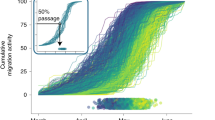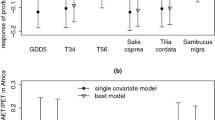Abstract
Avian migration is one of Earth’s largest processes of biomass transport, involving billions of birds. We estimated continental biomass flows of nocturnal avian migrants across the contiguous United States using a network of 143 weather radars. We show that, relative to biomass leaving in autumn, proportionally more biomass returned in spring across the southern United States than across the northern United States. Neotropical migrants apparently achieved higher survival during the combined migration and non-breeding period, despite an average three- to fourfold longer migration distance, compared with a more northern assemblage of mostly temperate-wintering migrants. Additional mortality expected with longer migration distances was probably offset by high survival in the (sub)tropics. Nearctic–Neotropical migrants relying on a ‘higher survivorship’ life-history strategy may be particularly sensitive to variations in survival on the overwintering grounds, highlighting the need to identify and conserve important non-breeding habitats.
This is a preview of subscription content, access via your institution
Access options
Access Nature and 54 other Nature Portfolio journals
Get Nature+, our best-value online-access subscription
$29.99 / 30 days
cancel any time
Subscribe to this journal
Receive 12 digital issues and online access to articles
$119.00 per year
only $9.92 per issue
Buy this article
- Purchase on Springer Link
- Instant access to full article PDF
Prices may be subject to local taxes which are calculated during checkout




Similar content being viewed by others
Data availability
NEXRAD weather radar data were accessed from the public ‘noaa-nexrad-level2’ Amazon S3 bucket20 (https://aws.amazon.com/public-datasets/nexrad/).
References
Hahn, S., Bauer, S. & Liechti, F. The natural link between Europe and Africa—2.1 billion birds on migration. Oikos 118, 624–626 (2009).
Bauer, S. & Hoye, B. J. Migratory animals couple biodiversity and ecosystem functioning worldwide. Science 344, 1242552 (2014).
Hu, G. et al. Mass seasonal bioflows of high-flying insect migrants. Science 354, 1584–1587 (2016).
Holland, R. A., Wikelski, M. & Wilcove, D. S. How and why do insects migrate? Science 313, 794–796 (2006).
Faaborg, J. et al. Conserving migratory landbirds in the New World: do we know enough? Ecol. Appl. 20, 398–418 (2010).
Klaassen, R. et al. When and where does mortality occur in migratory birds? Direct evidence from long‐term satellite tracking of raptors. J. Anim. Ecol. 83, 176–184 (2014).
Sillett, T. S. & Holmes, R. T. Variation in survivorship of a migratory songbird throughout its annual cycle. J. Anim. Ecol. 71, 296–308 (2002).
Faaborg, J. et al. Recent advances in understanding migration systems of New World land birds. Ecol. Monogr. 80, 3–48 (2010).
Rushing, C. S. et al. Spatial and temporal drivers of avian population dynamics across the annual cycle. Ecology 98, 2837–2850 (2017).
Wilcove, D. & Wikelski, M. Going, going, gone: is animal migration disappearing? PLoS Biol. 6, 1361–1364 (2008).
La Sorte, F. A., Fink, D., Hochachka, W. M. & Kelling, S. Convergence of broad-scale migration strategies in terrestrial birds. Proc. R. Soc. B 283, 20152588 (2016).
Webster, M. S., Marra, P. P., Haig, S. M., Bensch, S. & Holmes, R. T. Links between worlds: unraveling migratory connectivity. Trends Ecol. Evol. 17, 76–83 (2002).
Sauer, J. R., Pendleton, G. W., Peterjohn, B. G. & Peterjohnt, B. G. Evaluating causes of population change in North American insectivorous songbirds. Conserv. Biol. 10, 465–478 (1996).
Marra, P. P. Linking winter and summer events in a migratory bird by using stable-carbon isotopes. Science 282, 1884–1886 (1998).
Anders, A. D. & Marshall, M. R. Increasing the accuracy of productivity and survival estimates in assembling landbird population status. Conserv. Biol. 19, 66–74 (2005).
Lok, T., Overdijk, O. & Piersma, T. The cost of migration: spoonbills suffer higher mortality during trans-Saharan spring migrations only. Biol. Lett. 11, 20140944 (2015).
Grüebler, M. U., Korner-Nievergelt, F. & Naef-Daenzer, B. Equal nonbreeding period survival in adults and juveniles of a long-distant migrant bird. Ecol. Evol. 4, 756–765 (2014).
Crum, T. D. & Alberty, R. L. The WSR-88D and the WSR-88D Operational Support Facility. Bull. Am. Meteorol. Soc. 74, 1669–1687 (1993).
Bauer, S. et al. From agricultural benefits to aviation safety: realizing the potential of continent-wide radar networks. BioScience 67, 912–918 (2017).
Ansari, S. et al. Unlocking the potential of NEXRAD data through NOAA’s Big Data Partnership. Bull. Am. Meteorol. Soc. 99, 189–204 (2017).
Dokter, A. M. et al. Bird migration flight altitudes studied by a network of operational weather radars. J. R. Soc. Interface 8, 30–43 (2011).
La Sorte, F. A., Fink, D., Hochachka, W. M., Delong, J. P. & Kelling, S. Spring phenology of ecological productivity contributes to the use of looped migration strategies by birds. Proc. R. Soc. B 281, 20140984 (2014).
Avian Conservation Assessment Database (Partners in Flight, 2017); http://pif.birdconservancy.org/ACAD/
PIF Population Estimates Database (Partners in Flight Science Committee, 2013); http://pif.birdconservancy.org/PopEstimates
La Sorte, F. A. & Fink, D. Projected changes in prevailing winds for transatlantic migratory birds under global warming. J. Anim. Ecol. 86, 273–284 (2017).
Faaborg, J. et al. Recent advances in understanding migration systems of New World land birds. Ecol. Monogr. 80, 3–48 (2010).
Cody, M. L. A general theory of clutch size. Evolution 20, 174–184 (1966).
Böhning-Gaese, K., Halbe, B., Lemoine, N. & Oberrath, R. Factors influencing the clutch size, number of broods and annual fecundity of North American and European land birds. Evol. Ecol. Res. 2, 823–839 (2000).
Martin, T. E. Avian life history evolution in relation to nest sites, nest predation, and food. Ecol. Monogr. 65, 101–127 (1995).
Schmidt, K. A., Rush, S. A. & Ostfeld, R. S. Wood thrush nest success and post-fledging survival across a temporal pulse of small mammal abundance in an oak forest. J. Anim. Ecol. 77, 830–837 (2008).
Anders, A. D., Dearborn, D. C., Faaborg, J. & Thompson, F. R. Juvenile survival in a population of Neotropical migrant birds. Conserv. Biol. 11, 698–707 (1997).
Vitz, A. C. & Rodewald, A. D. Influence of condition and habitat use on survival of post-fledging songbirds. Condor 113, 400–411 (2011).
Saether, B., Bakke, O. & Mar, N. Avian life history variation and contribution of demographic traits to the population growth rate. Ecology 81, 642–653 (2000).
Root, T. L. et al. Fingerprints of global warming on wild animals and plants. Nature 421, 57–60 (2003).
Van Doren, B. M., Sheldon, D., Geevarghese, J., Hochachka, W. M. & Farnsworth, A. Autumn morning flights of migrant songbirds in the northeastern United States are linked to nocturnal migration and winds aloft. Auk 132, 105–118 (2015).
Gaston, K. J., Visser, M. E. & Holker, F. The biological impacts of artificial light at night: the research challenge. Phil. Trans. R. Soc. B 370, 20140133 (2015).
Loss, S. R., Will, T. & Marra, P. P. Direct mortality of birds from anthropogenic causes. Annu. Rev. Ecol. Evol. Syst. 46, 99–120 (2015).
La Sorte, F. A. et al. Global change and the distributional dynamics of migratory bird populations wintering in Central America. Glob. Change Biol. 23, 5284–5296 (2017).
Bringi, V. N. & Chandrasekar, V. Polarimetric Doppler Weather Radar (Cambridge Univ. Press, Cambridge, 2001).
Stepanian, P. M., Horton, K. G., Melnikov, V. M., Zrnić, D. S. & Gauthreaux, S. A. Dual-polarization radar products for biological applications. Ecosphere 7, e01539 (2016).
Krajewski, W. F., Ntelekos, A. A. & Goska, R. A GIS-based methodology for the assessment of weather radar beam blockage in mountainous regions: two examples from the US NEXRAD network. Comput. Geosci. 32, 283–302 (2006).
USGS Small-Scale Dataset—100-Meter Resolution Elevation of the Conterminous United States 201212 TIFF (U.S. Geological Survey, 2012); https://www.sciencebase.gov/catalog/item/581d0539e4b08da350d52552
Doviak, R. J. & Zrnić, D. S. Doppler Radar and Weather Observations (Academic Press, San Diego, 1993).
Haase, G. & Landelius, T. Dealiasing of Doppler radar velocities using a torus mapping. J. Atmospheric Ocean. Technol. 21, 1566–1573 (2004).
Heistermann, M. et al. The emergence of open-source software for the weather radar community. Bull. Am. Meteorol. Soc. 96, 117–128 (2015).
Sheldon, D. et al. Approximate Bayesian inference for reconstructing velocities of migrating birds from weather radar. In Proc. 27th AAAI Conference on Artificial Intelligence 1334–1340 (AAAI Press, 2013).
Waldteufel, P. & Corbin, H. On the analysis of single-Doppler radar data. J. Appl. Meteorol. 18, 532–542 (1978).
Holleman, I. Quality control and verification of weather radar wind profiles. J. Atmospheric Ocean. Technol. 22, 1541–1550 (2005).
Vaughn, C. R. Birds and insects as radar targets: a review. Proc. IEEE 73, 205–227 (1985).
Merkel, D. Docker: lightweight Linux containers for consistent development and deployment. Linux J. 2014, 2 (2014).
Alerstam, T. Flight by night or day? Optimal daily timing of bird migration. J. Theor. Biol. 258, 530–536 (2009).
Pebesma, E. J. Multivariable geostatistics in S: the gstat package. Comput. Geosci. 30, 683–691 (2004).
Westbrook, J. K. Noctuid migration in Texas within the nocturnal aeroecological boundary layer. Integr. Comp. Biol. 48, 99–106 (2008).
Drake, V. A. & Reynolds, D. R. Radar Entomology: Observing Insect Flight and Migration (CABI, Wallingford, Boston, 2012).
Dunning, J. B. Jr CRC Handbook of Avian Body Masses 2nd edn (CRC Press, Boca Raton, 2008).
Ridgely, R. S. et al. Digital Distribution Maps of the Birds of the Western Hemisphere Version 3.0. (NatureServe, 2017).
La Sorte, F. A., Hochachka, W. M., Farnsworth, A., Dhondt, A. A. & Sheldon, D. The implications of mid-latitude climate extremes for North American migratory bird populations. Ecosphere 7, e01261 (2016).
Sahr, K. Hexagonal discrete global grid systems for geospatial computing. Arch. Photogramm. Cartogr. Remote Sens. 22, 363–376 (2011).
Bates, D., Mächler, M., Bolker, B. M. & Walker, S. C. Fitting linear mixed-effects models using lme4. J. Stat. Softw. 67, 1–48 (2015).
Fox, J. & Weisberg, S. An R Companion to Applied Regression (Sage, Thousand Oaks, 2002).
Acknowledgements
This work was supported through a Rose Postdoctoral Fellowship (to A.M.D.), AWS Cloud Credits for Research (to A.M.D.), NSF ABI innovation DBI-1661259 (to A.M.D. and F.A.L.S.), the Leon Levy Foundation (to A.F. and D.F.), National Fish and Wildlife Foundation 6001.16.052172 (to A.F. and S.K.), NSF IIS-1633206 (to A.F. and S.K.), NSF ABI sustaining DBI-1356308 (to F.A.L.S., D.F. and S.K.) and the Wolf Creek Charitable Foundation (F.A.L.S.).
Author information
Authors and Affiliations
Contributions
A.M.D., A.F. and S.K. conceived the study. A.M.D. performed the research and analysed the data. F.A.L.S. calculated species breeding and wintering distribution centroids. K.V.R. compiled transect species compositions from PIF population estimates. A.M.D. wrote the paper with input from all authors.
Corresponding author
Ethics declarations
Competing interests
The authors declare no competing interests.
Additional information
Publisher’s note: Springer Nature remains neutral with regard to jurisdictional claims in published maps and institutional affiliations.
Supplementary information
Supplementary Information
Supplementary text; Supplementary references; Supplementary Figures 1–5; Supplementary Tables 1–6; Captions to Supplementary Videos
Supplementary Video 1
Nightly migration traffic mt⊥ (accumulated per night, in blue-white linear colour scale) and average ground speed direction (orange arrows) during spring from 1 March 2016 to 30 June
Supplementary Video 2
Nightly migration traffic mt⊥ (accumulated per night, in blue-white linear colour scale) and average ground speed direction (orange arrows) during spring from 1 August 2016 to 30 November
Supplementary Video 3
Seasonally accumulating migration traffic mt⊥ (accumulated from 1 March 2016 until video frame time stamp, in blue-white logarithmic colour scale) up to 30 June 2016
Supplementary Video 4
Seasonally accumulating migration traffic mt⊥ (accumulated from 1 August 2016 until video frame time stamp, in blue-white logarithmic colour scale) up to 30 November 2016
Rights and permissions
About this article
Cite this article
Dokter, A.M., Farnsworth, A., Fink, D. et al. Seasonal abundance and survival of North America’s migratory avifauna determined by weather radar. Nat Ecol Evol 2, 1603–1609 (2018). https://doi.org/10.1038/s41559-018-0666-4
Received:
Accepted:
Published:
Issue Date:
DOI: https://doi.org/10.1038/s41559-018-0666-4
This article is cited by
-
Artificial light at night is a top predictor of bird migration stopover density
Nature Communications (2023)
-
A cold high-pressure system over North China hinders the southward migration of Mythimna separata in autumn
Movement Ecology (2022)
-
Multi-scale temporal variation in bird-window collisions in the central United States
Scientific Reports (2021)
-
Global population trends in shorebirds: migratory behaviour makes species at risk
The Science of Nature (2021)
-
Testing four hypotheses to explain partial migration: balancing reproductive benefits with limits to fasting endurance
Behavioral Ecology and Sociobiology (2020)



